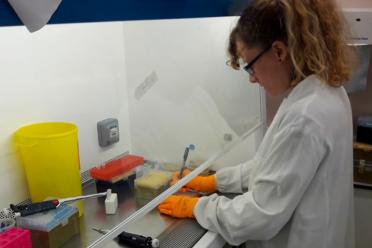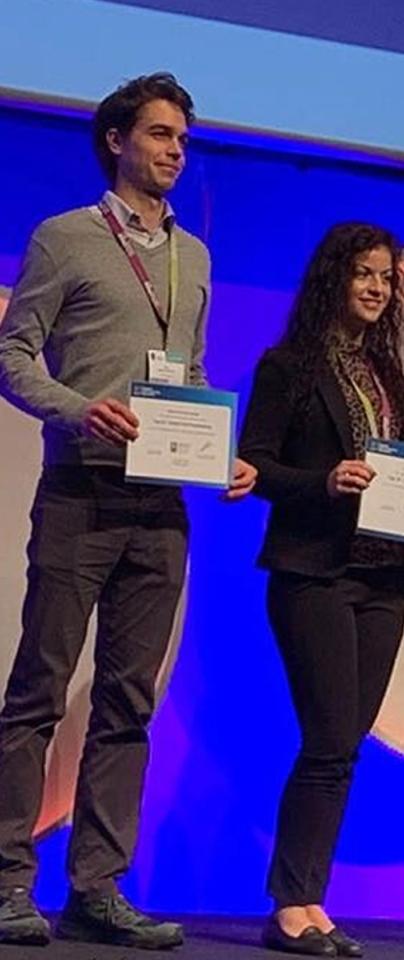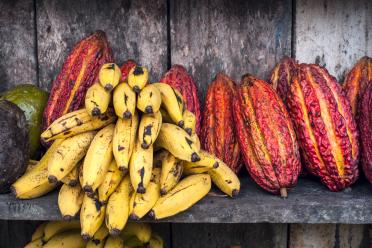Women in computing: guts, bioinformatics and yoghurt
Agatha Treveil is in the third year of her PhD, which she says is her favourite yet! How did she get into bioinformatics, and where will it take her?
Agatha Treveil is in the third year of her PhD, which she says is her favourite yet! How did she get into bioinformatics, what is she learning about yoghurt and guts, and where will it take her?
We asked Agatha, who works in the Korcsmáros group, all about her PhD, how she got into bioinformatics, what’s so important about yoghurt, and how it feels to be an award winning speaker so early on in her career!
No! I may be in my third year, but I’ve still got 1½ years left. I did a fair amount of stuff in the first 2 years of my PhD, but unfortunately (as PhDs often go), not much of that will make it to my thesis.
Thankfully, everything has started coming together recently, so I finally have some confidence that I can complete. But not for at least another year!
Depends what you call ‘yoghurt’. If you stay clear of the sugar-packed, fat free, pasteurized yoghurts and find instead those which call themselves ‘live’ or ‘natural’, you’ll likely find yourself eating probiotic bacteria. One such example is Bifidobacteria, which is the type of bacteria my PhD focuses on.
Many studies have shown that Bifidobacteria (which is a normal gut inhabitant) is beneficial to health, particularly gut and inflammatory conditions. However, it’s controversial because we don’t yet have a full understanding of how Bifidobacteria works, and additionally, evidence that eating probiotics helps certain health conditions is mixed.
It seems that results depend on many factors such as age and current gut microflora of recipient. My work looks at one possible method of action of Bifidobacteria in the gut to help the community understand what it does that confers health benefits.

Based on the previous answer, you might be able to guess? … natural yoghurt :)
Of course, I am not averse to sugar-packed chocolate yogurts. I just try to eat less of them.
Paneth cells are a type of cell found in the small intestine. Their main role is to release antimicrobial peptides, which, as the name suggests, kill microbes, such as bacteria and fungi.
In doing this, they help to maintain the balance of microbes in the gut and they help prevent bacteria from crossing through the gut lining and causing infection. Dysfunctioning of Paneth cells has been associated with inflammatory bowel diseases, such as Crohn’s disease. Therefore, it is important to understand how they work, and how they are affected by probiotic bacteria such as Bifidobacteria.

Dysfunctioning of Paneth cells has been associated with inflammatory bowel diseases, such as Crohn’s disease. Therefore, it is important to understand how they work, and how they are affected by probiotic bacteria such as Bifidobacteria.

Lindsay Hall, a group leader at QIB specialising in Bifidobacteria, is the secondary supervisor of my PhD. Last summer I joined her and her group in London at the Royal Society Summer Science Exhibition.
We exhibited a large, interactive walk-through gut, which we used to teach the public about the diverse population of microbes in our intestines and the effect they can have on health. It was really exhausting talking to this quantity of people, but I had a great time.
I was amazed at how interested people were about learning (even the school children) and also shocked at how many people claimed to know someone close who suffers or has suffered from a health condition potentially linked to the gut microbiome.
I was never going to go into computing. My parents are both computer programmers and I decided early on that I was going to do something different.
When choosing what to do at university, I opted not for the subject I found the easiest, but the subject I found most interesting - Biology. Whilst at university I got the opportunity to spend a year working in a biotech company in Oxford. During this year I was introduced to Bioinformatics - and I loved it.
It turns out I must have inherited something from my parents because I find the logic and problem solving of computing really engaging. However, as opposed to working for some insurance company or something equally dull, I get to apply these computational techniques to think about biology and health.
A lot of the bioinformatics I do involves taking RNA sequencing data and trying to understand what it means biologically using a network approach.
In effect I am using computers to pull together lots of published data on molecular interactions within cells and to use that to make sense of large quantities of sequencing data.
I often describe myself as a “Jack of all trades”. I like to see of myself as a bioinformatician, but I was trained as a biologist and I sometimes go to the lab.
I may not be the most experienced person at any particular topic or technique, but understanding all aspects of my already interdisciplinary project is a very good position to be in.

Organoids are miniature tissue cultures grown from stem cells. In our group, we are developing organoids of the gut lining, which enable us to easily test the response of the gut lining to different conditions (eg. what does Bifidobacteria do?).
In the future we hope to be able to grow organoids from human biopsies to enable patient-specific studies.
When I was working in Oxford almost all of my colleagues had PhDs. I realised that if I wanted to pursue a job in bioinformatics I would probably have to do a PhD.
The last few years has confirmed to me that academia is not perfectly well suited to me, so I expect, as originally planned, I’ll end up in industry or the public sector post-PhD.
Luckily many of the techniques and skills I’ve learnt during my PhD will also be applicable outside of academia.
I spoke about a collaborative project I’ve been working on where we have developed a pipeline to generate regulatory networks (a map of molecular interactions) of gut cells.

I presented, at a large conference on inflammatory bowel disease, how we plan to apply this pipeline to study dysfunctioning Paneth cells.


I presented, at a large conference on inflammatory bowel disease, how we plan to apply this pipeline to study dysfunctioning Paneth cells.

Dave of course! Who else?
Last year my partner and I adopted a young cockapoo. Due to his intense personality and bad habits, he has taken up much of my free time for a while. Now that he is making lots of progress it’s become very enjoyable to spend time with him. Other than this, I like to dabble in creative hobbies (including crochet).
My current interest is learning to make my own clothes. I also play viola in the UEA symphony orchestra, but that is more of a long term hobby.

Agatha Treveil is a PhD student at Earlham Institute funded by:
BBSRC Norwich Research Park Biosciences Doctoral Training Partnership (grant BB/M011216/1)

Postdoctoral Scientist Nasmille Larke-Mejía is researching to help improve agricultural practices and increase crop yield as well as impacting the socioeconomic landscape in Colombia, as part of our GROW initiative funded by GCRF-UKRI.

In our third installment, Pilar Corredor-Moreno, a PhD student in the Saunder’s Group studying wheat yellow rust at EI, shares her fascinating and honest opinions on computing.

Exploring the basics of bioinformatics at the Earlham Institute - the rewards and the lessons learned.

Katie Barr tells us what she thinks may lie in store for those starting out in the world of coding.

We interview Vanessa Bueno of the Saunders Group, who is a predoctoral student working on wheat yellow rust.

For many in the bioinformatics world, learning to code is a leap into the unknown. What’s it like doing a bioinformatics PhD?

Arguably, the question here should be, why is Ada Lovelace not more famous?

Dr Laura-Jayne Gardiner realised how essential a bioinformatics skill set was to keep up with advanced genomics - placing her in great stead to becoming an independent researcher.

Ada Lovelace Day is an international celebration of the achievements of women in science and technology but behind this are the remarkable achievements of the very first computer programmer.